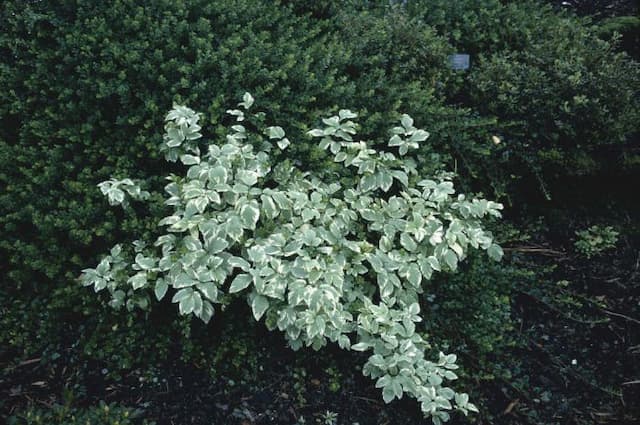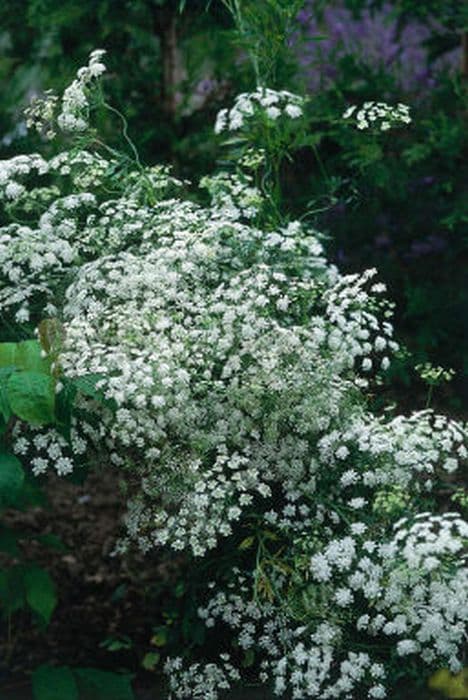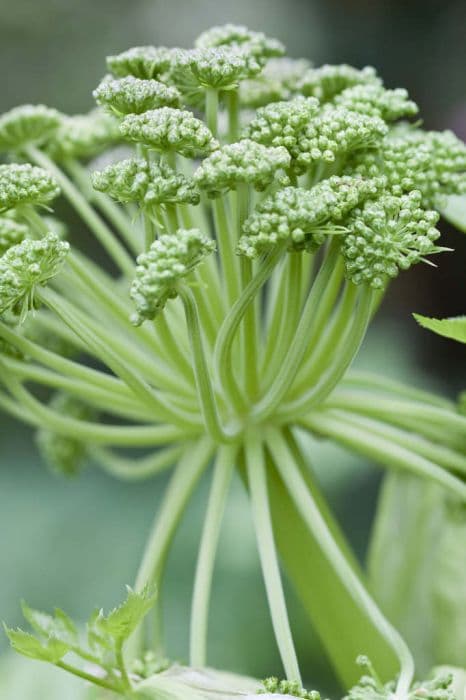Shrubby Hare's Ear Bupleurum fruticosum

ABOUT
Bupleurum fruticosum, commonly known as shrubby hare's ear, is a perennial plant that is noted for its distinctive foliage and flowers. The plant has a bushy and rounded growth habit, presenting a dense mass of leaves that make it quite attractive. Its leaves are leathery and elongated, with a glossy, dark green color on the upper surface and a paler green beneath. The leaf shape is narrow and somewhat lance-shaped, featuring a smooth and slightly undulating margin. During the blooming season, shrubby hare's ear produces umbels of tiny, star-shaped flowers. The flowers are generally a pale yellow or greenish-yellow color, which creates a nice contrast with the dark green foliage. These flower clusters emerge at the end of long, slender stems that rise above the foliage, giving the plant a somewhat airy appearance. After flowering, small seed heads may form, which also have a decorative character. As an evergreen plant, shrubby hare's ear maintains its foliage throughout the year, making it an excellent choice for gardeners who wish to have continuous greenery in their landscapes. Overall, the shrubby hare's ear has an elegant and subtle beauty, with its combination of attractive leaves and delicate flowers.
About this plant
 Names
NamesSynonyms
Shrubby Hare's-ear, Woody Thoroughwax
Common names
Bupleurum fruticescens, Bupleurum lancifolium, Bupleurum rotundifolium, Tenoria fruticosa, Bupleurum fruticosum.
 Toxicity
ToxicityTo humans
Bupleurum fruticosum, commonly known as Shrubby Hare's-ear, does not have a widespread reputation for being toxic to humans. There is limited information on the toxicity of this specific species to humans, and it is not commonly reported to cause poisoning when touched or ingested. However, as with any plant, individual allergies or sensitivities can occur, and it is always advisable to exercise caution and avoid ingesting plants that are not known to be safe for consumption.
To pets
Shrubby Hare's-ear is not commonly known to be toxic to pets such as dogs and cats. There is little evidence to suggest that Bupleurum fruticosum poses a significant risk if ingested by pets. That being said, caution should still be taken to prevent pets from eating plants, as individual animals may have unique sensitivities, and non-toxic plants can still cause gastrointestinal upset if ingested in large quantities.
 Characteristics
CharacteristicsLife cycle
Perennials
Foliage type
Evergreen
Color of leaves
Green
Flower color
Yellow
Height
3 feet (0.91 meters)
Spread
3 feet (0.91 meters)
Plant type
Shrub
Hardiness zones
7
Native area
Mediterranean
Benefits
 General Benefits
General Benefits- Landscape decoration: Bupleurum fruticosum, commonly known as Shrubby Hare's-ear, is an evergreen shrub that adds year-round visual interest to gardens and landscapes.
- Drought resistance: Once established, it is very drought-tolerant, requiring minimal water, which makes it suitable for xeriscaping and water-efficient gardens.
- Low maintenance: It generally requires little maintenance, pruning, or care, which is ideal for gardeners looking for low-maintenance plants.
- Wildlife attraction: The plant can attract beneficial insects and pollinators such as bees to the garden, supporting biodiversity.
- Erosion control: With its robust root system, Bupleurum fruticosum can help stabilize soil and prevent erosion on slopes or in areas prone to soil degradation.
- Windbreak: The dense foliage and sturdy growth habit make it a good choice for a natural windbreak or privacy screen.
- Habitat creation: It provides shelter and nesting sites for wildlife, contributing to the creation of a healthy ecosystem.
 Medical Properties
Medical Properties- Anti-inflammatory: Bupleurum fruticosum contains compounds that may help reduce inflammation.
- Hepatoprotective: It is believed to have liver-protecting properties.
- Immunomodulatory: The plant may influence the immune system, potentially modulating immune responses.
- Antipyretic: Traditionally used to help reduce fever.
- Antiviral: Some components might have antiviral effects.
- Adaptogenic: May help the body adapt to stress and exert a normalizing effect upon bodily processes.
 Air-purifying Qualities
Air-purifying QualitiesThis plant is not specifically known for air purifying qualities.
 Other Uses
Other Uses- Insect Repellent: Bupleurum fruticosum, commonly known as Shrubby Hare's-ear, can be used as a natural insect repellent due to its strong scent which is often unappealing to insects.
- Dye Production: The root of Shrubby Hare's-ear is sometimes used for producing a yellow dye for textiles.
- Ornamental Use: With its attractive foliage and yellow flowers, it is commonly used in garden landscapes and as a decorative hedge.
- Floral Arrangements: The long-lasting flowers and branches of Shrubby Hare's-ear are used in floral arrangements and bouquets.
- Privacy Screening: Because of its dense growth, it is often planted to create a natural privacy screen in gardens and parks.
- Windbreaks: Its robust and dense nature allows it to be planted as a windbreak to protect more delicate plants.
- Erosion Control: The plant’s extensive root system can help stabilize slopes and prevent soil erosion.
- Traditional Crafts: The flexible branches may be used in traditional crafts, such as basket weaving.
- Fragrance Production: The essential oils extracted from the plant can be used in perfumery and aromatherapy products.
- Ecological Support: Offering shelter and food, Shrubby Hare's-ear provides ecological support to a variety of insects and birds.
Interesting Facts
 Feng Shui
Feng ShuiThe Shrubby Hare's Ear is not used in Feng Shui practice.
 Zodiac Sign Compitability
Zodiac Sign CompitabilityThe Shrubby Hare's Ear is not used in astrology practice.
 Plant Symbolism
Plant Symbolism- Longevity: Bupleurum, also known as Shrubby Hare's Ear, is a hardy perennial plant that can live for several years in the right conditions. Its long lifespan makes it a symbol for longevity and enduring life.
- Resistance: As a plant that's tough and can stand up to harsh conditions, Shrubby Hare's Ear represents the ability to withstand adversity and stress.
- Healing: Bupleurum has been used in traditional Chinese medicine for centuries, where it's known for its healing properties. As such, it symbolizes health and recovery.
- Balance: In herbal medicine, Bupleurum is believed to help balance the body. Symbolically, this plant represents harmony and equilibrium in life.
 Water
WaterFor Shrubby Hare's Ear, watering should be moderate and consistent during the growing season, reducing frequency in the winter. Water the plant when the top inch of soil feels dry to the touch, which would typically amount to once a week. An estimation might be about 1 gallon for an outdoor shrub depending on size and environmental conditions. During hot summer days, watering might be increased to accommodate the plant's needs. Ensure proper drainage to prevent waterlogging, which can lead to root rot.
 Light
LightShrubby Hare's Ear thrives best in full sun to partial shade conditions. A spot that receives at least 6 hours of direct sunlight is ideal for this plant, while some afternoon shade can be beneficial in particularly hot climates. Avoid placing it in deep shade, as this will affect its growth and flowering potential.
 Temperature
TemperatureShrubby Hare's Ear is hardy and adaptable to a range of temperatures, tolerating a minimum of around 20°F (-6°C) and thriving in temperatures up to 90°F (32°C) or higher. However, the ideal temperature range for this plant is between 50°F and 80°F (10°C to 27°C). It's important to protect this shrub from harsh winter winds and excessively low winter temperatures.
 Pruning
PruningShrubby Hare's Ear should be pruned to maintain shape and encourage bushier growth, typically once a year after it has flowered. Light pruning is sufficient; too much can hinder its natural form. Eliminate any dead or damaged branches to keep the plant healthy. The best time for this is late winter or early spring before new growth begins.
 Cleaning
CleaningAs needed
 Soil
SoilShrubby Hare's Ear requires well-drained soil with a pH ranging from neutral to slightly alkaline. A mix with equal parts of garden soil, coarse sand, and peat or compost is ideal to provide the right balance of drainage and fertility.
 Repotting
RepottingShrubby Hare's Ear is a slow-growing shrub that generally does not require frequent repotting. It is typically repotted only when it outgrows its container, which could be several years apart.
 Humidity & Misting
Humidity & MistingShrubby Hare's Ear tolerates a wide range of humidity levels and does not require any special humidity considerations, making it adaptable to typical outdoor conditions.
 Suitable locations
Suitable locationsIndoor
Ensure bright light and avoid overwatering.
Outdoor
Plant in full sun, in well-draining soil.
Hardiness zone
7-10 USDA
 Life cycle
Life cycleBupleurum fruticosum, commonly known as Shrubby Hare's Ear, begins its life cycle as a seed, which germinates in late winter to early spring in well-drained soils with full to partial sun exposure. The seedling then develops into a woody perennial shrub, growing steadily as it forms a deep root system and woody stems. Over the following years, the plant matures and begins to produce its characteristic small, yellow-green flowers in compound umbels during the summer months, which are pollinated by insects. After pollination, the flowers turn into fruit, which are small capsules containing seeds that are either dropped nearby or dispersed by wind or animals. As the Bupleurum fruticosum is a perennial, it will enter a period of dormancy in the fall and winter, preserving energy in its woody stems and roots to survive the cold. With spring's arrival, the plant emerges from dormancy, continuing its growth cycle by producing new shoots and leaves, eventually leading to flowering and seed production again.
 Propogation
PropogationPropogation time
Spring to early summer
Bupleurum fruticosum, commonly known as Shrubby Hare's-ear, can be propagated through seed sowing. The ideal time for sowing seeds of Shrubby Hare's-ear is in the late winter to early spring months, just before the last frost date when the soil can be worked. To propagate by seed, one should first prepare a suitable seed-starting mix and ensure that pots or trays have adequate drainage. Seeds need to be sown shallowly, no more than an eighth of an inch (about 3 millimeters) deep, and kept moist until germination, which typically occurs in two to three weeks. Once seedlings are large enough to handle, they can be transplanted into individual pots and later moved to their final position in the garden when they are robust enough to withstand the elements.









